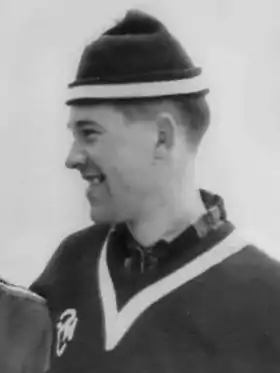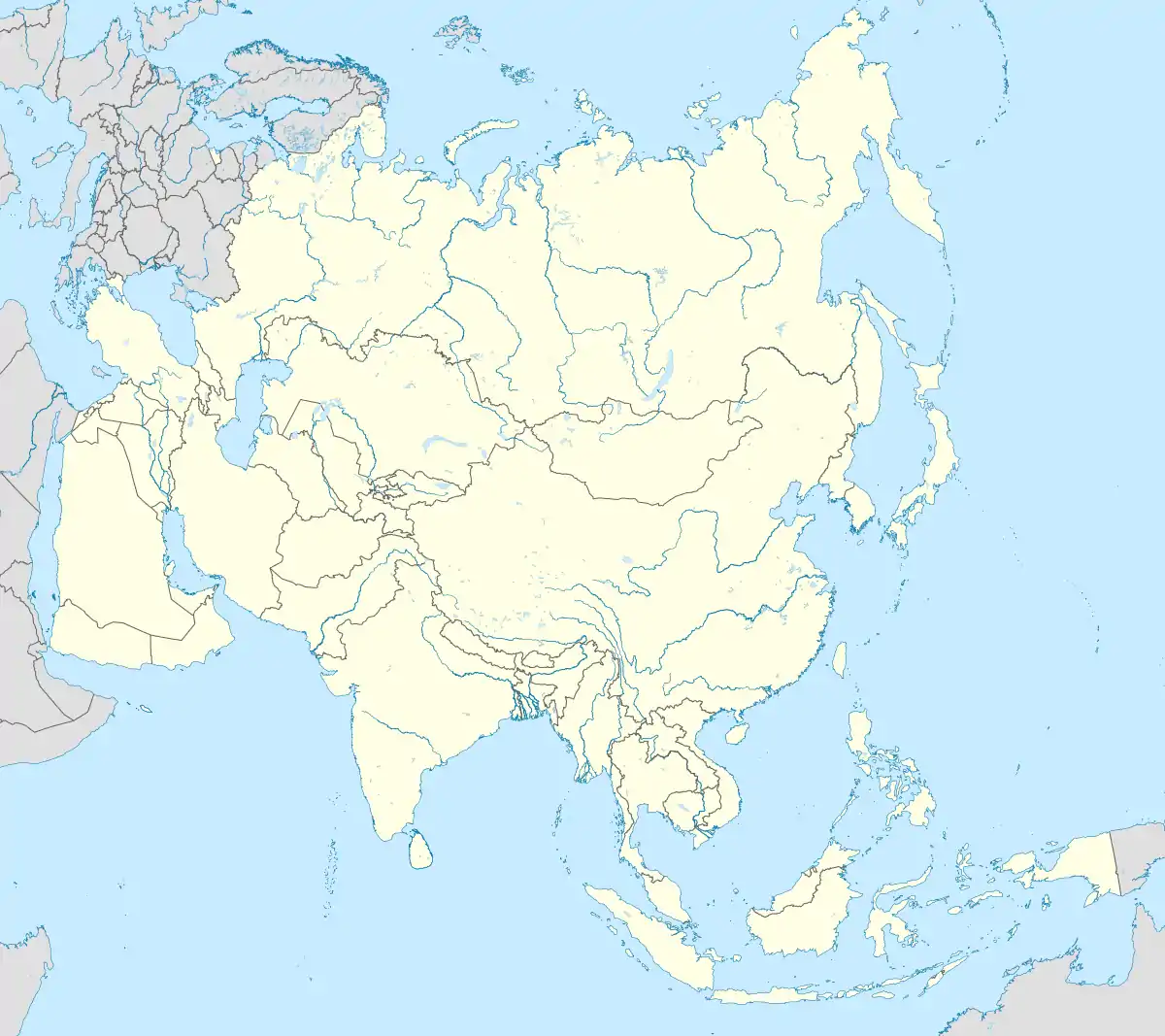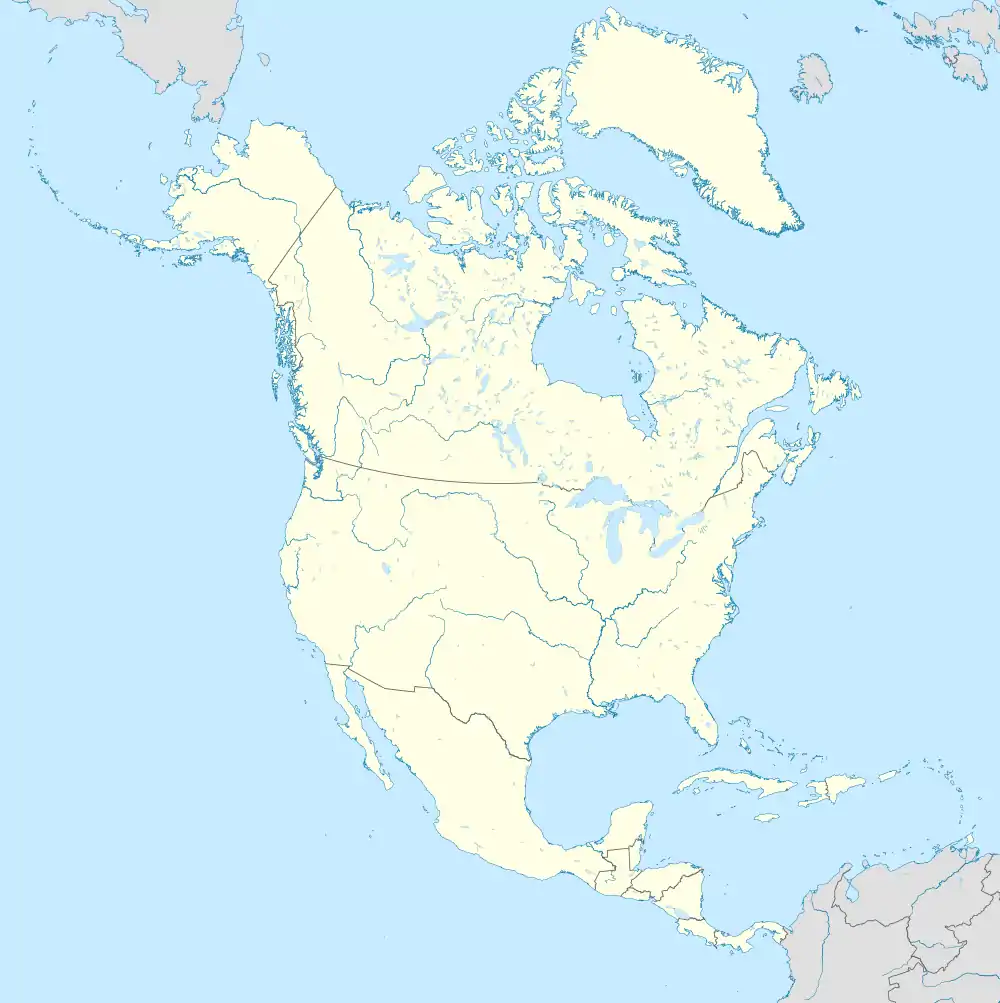FIS Ski Jumping World Cup
The FIS Ski Jumping World Cup is the world's highest level of ski jumping and the FIS Ski Flying World Cup as the subdivisional part of the competition. It was founded by Torbjørn Yggeseth for the 1979/80 season and organized by the International Ski Federation. Women began competing during the 2011/12 season.[1]
| Ski Jumping World Cup | |
|---|---|
 Torbjørn Yggeseth (Norway), founder of World Cup | |
| Genre | ski jumping (1808) ski flying (1936) |
| Location(s) | Europe Japan Russia Canada (rare) Kazakhstan (rare) South Korea (rare) United States (rare) |
| Inaugurated | 27 December 1979 (men) 12 January 1992 (men's team) 3 December 2011 (women) 23 November 2012 (mixed) 16 December 2017 (Women's team) |
| Founder | |
| Organised by | International Ski Federation |
| People | Current race directors: |
| Sponsor | Viessmann, Konica Minolta |
The rounds are hosted primarily in Europe, with regular stops in Japan and rarely in North America. These have been hosted in 20 different countries around the world for both men and women: Austria, Bosnia, Canada, Czech Republic, Finland, France, Germany, Italy, Japan, Kazakhstan, Norway, Poland, Romania, Russia, Slovakia, Slovenia, South Korea, Sweden, Switzerland and the United States.[2][nb 1]
Summer Grand Prix is the top level summer competition on plastic. The lower competitive circuits include the Continental Cup, the FIS Cup, the FIS Race and the Alpen Cup.
Global map of all world cup hosts
The maps display all 64 locations around the globe that have hosted World Cup events for men (57) and women (20) at least one time in the history of the competition. Pyeongchang in 2017 was the latest new host.
|
| ||||||||
![]() Four Hills Tournament (1979– )
Four Hills Tournament (1979– )
![]() Nordic Tour (1997–2010); Raw Air (2017– )
Nordic Tour (1997–2010); Raw Air (2017– )
![]() Swiss Tour (1980–1992)
Swiss Tour (1980–1992)
![]() Bohemia Tour (1981–1994)
Bohemia Tour (1981–1994)
![]() Nordic Tour (1997–2010)
Nordic Tour (1997–2010)
![]() FIS Team Tour (Oberstdorf included, 2009–2013)
FIS Team Tour (Oberstdorf included, 2009–2013)
Scoring system
Each season consists of 25–30 competitions, usually two competitions on the same hill during a weekend. One competition consists of a qualifying round; first round, with 50 competitors; and second round, with 30. Qualifying round for the main event was introduced in 1990 to limit the number of competitors: the top 10 jumpers in FIS ranking qualify directly to the first round, while the rest of the jumpers fight for the remaining 40 spots. The top 30 in the first round advance to the second round, which is held in reverse order, so the best jumper in the first round jumps last. The aggregate score in the first and second rounds determine the competition results. The top 30 are awarded World Cup points. The winner gets 100 points while number 30 receives 1 point. At team events only top 8 receive points.
Men's Individual
| Seasons | 1 | 2 | 3 | 4 | 5 | 6 | 7 | 8 | 9 | 10 | 11 | 12 | 13 | 14 | 15 | 16 | 17 | 18 | 19 | 20 | 21 | 22 | 23 | 24 | 25 | 26 | 27 | 28 | 29 | 30 |
|---|---|---|---|---|---|---|---|---|---|---|---|---|---|---|---|---|---|---|---|---|---|---|---|---|---|---|---|---|---|---|
| 1979/80–1992/93 | 25 | 20 | 15 | 12 | 11 | 10 | 9 | 8 | 7 | 6 | 5 | 4 | 3 | 2 | 1 | points were not awarded | ||||||||||||||
| 1993/94–present | 100 | 80 | 60 | 50 | 45 | 40 | 36 | 32 | 29 | 26 | 24 | 22 | 20 | 18 | 16 | 15 | 14 | 13 | 12 | 11 | 10 | 9 | 8 | 7 | 6 | 5 | 4 | 3 | 2 | 1 |
Women's Individual
| Seasons | 1 | 2 | 3 | 4 | 5 | 6 | 7 | 8 | 9 | 10 | 11 | 12 | 13 | 14 | 15 | 16 | 17 | 18 | 19 | 20 | 21 | 22 | 23 | 24 | 25 | 26 | 27 | 28 | 29 | 30 |
|---|---|---|---|---|---|---|---|---|---|---|---|---|---|---|---|---|---|---|---|---|---|---|---|---|---|---|---|---|---|---|
| 2011/12–present | 100 | 80 | 60 | 50 | 45 | 40 | 36 | 32 | 29 | 26 | 24 | 22 | 20 | 18 | 16 | 15 | 14 | 13 | 12 | 11 | 10 | 9 | 8 | 7 | 6 | 5 | 4 | 3 | 2 | 1 |
Men's team
| Seasons | 1 | 2 | 3 | 4 | 5 | 6 | 7 | 8 | 9 | 10 | 11 | 12 | 13 |
|---|---|---|---|---|---|---|---|---|---|---|---|---|---|
| 1991/92–1992/93 | 60 | 50 | 40 | 30 | 20 | 15 | 14 | 13 | 12 | 11 | 10 | 9 | 8 |
| 1993/94–1999/00 | 200 | 160 | 120 | 100 | 90 | 80 | points were not awarded | ||||||
| 2000/01–present | 400 | 350 | 300 | 250 | 200 | 150 | 100 | 50 | points are not being awarded | ||||
Women's team
| Seasons | 1 | 2 | 3 | 4 | 5 | 6 | 7 | 8 |
|---|---|---|---|---|---|---|---|---|
| 2017/18–present | 400 | 350 | 300 | 250 | 200 | 150 | 100 | 50 |
Men's standings
The table below shows the three highest ranked jumpers each year.
Ski Flying
|
Ski Jumping (JP) Cup
*This additional title was awarded five times from 1996 to 2000 for the best individual normal and large hill results only, not |
- Titles Overall:
| Rank | Nation | Wins | Second | Third | Total |
|---|---|---|---|---|---|
| 1 | 12 | 12 | 13 | 37 | |
| 2 | 8 | 4 | 7 | 19 | |
| 3 | 6 | 1 | 4 | 11 | |
| 4 | 3 | 7 | 3 | 13 | |
| 5 | 3 | 5 | 4 | 12 | |
| 6 | 3 | 2 | 5 | ||
| 7 | 1 | 3 | 2 | 6 | |
| 8 | 1 | 2 | 1 | 4 | |
| 9 | 1 | 1 | 5 | 7 | |
| 10 | 1 | 1 | 2 | ||
| 11 | 1 | 1 | |||
| 12 | 1 | 2 | 3 | ||
| 13 | 1 | 1 | |||
| 14 | 1 | 1 | |||
| Total | 40 | 40 | 40 | 122 | |
- Nations Cup:
| Rank | Nation | Wins | Second | Third | Total |
|---|---|---|---|---|---|
| 1 | 18 | 9 | 8 | 35 | |
| 2 | 8 | 11 | 8 | 27 | |
| 3 | 7 | 9 | 8 | 24 | |
| 4 | 3 | 3 | 3 | 9 | |
| 5 | 3 | 6 | 9 | 18 | |
| 6 | 2 | 2 | 4 | ||
| 7 | 2 | 2 | 4 | ||
| 8 | 1 | 1 | 2 | ||
| 9 | 1 | 1 | |||
| 10 | 1 | 1 | |||
| Total | 40 | 40 | 40 | 120 | |
- Ski Flying:
| Rank | Nation | Wins | Second | Third | Total |
|---|---|---|---|---|---|
| 1 | 8 | 5 | 5 | 18 | |
| 2 | 6 | 3 | 2 | 11 | |
| 3 | 4 | 3 | 2 | 8 | |
| 4 | 2 | 2 | |||
| 7 | 1 | 5 | 2 | 8 | |
| 5 | 1 | 2 | 3 | 6 | |
| 6 | 1 | 3 | 4 | ||
| 8 | 3 | 1 | 4 | ||
| 9 | 2 | 3 | 5 | ||
| 10 | 1 | 1 | |||
| 11 | 2 | 2 | |||
| Total | 21 | 22 | 20 | 64 | |
Men's tournaments
There are other tournaments as part of the World Cup:
K.O.P. International Ski Flying Week
Nordic Tournament
Raw Air
Planica7
|
Swiss Tournament
Bohemia Tournament
FIS Team Tour
Willingen Five
Titisee-Neustadt Five
|
Women's standings
Overall
Raw Air
Russia Tour Blue Bird
|
Nations Cup
Lillehammer Triple
|
Titles
Overall
|
Ski Flying
Ski Jumping (JP) Cup
|
Men's general statistics
| Events | Winners |
|---|---|
| 1019 | 165 |
Wins
|
Podiums
Top ten appearances
|
update: 31 January 2021
One country podium sweep
| No. | Date | Place | Season | Winner | Second | Third |
|---|---|---|---|---|---|---|
| 1 | 27 December 1979 | Cortina d'Ampezzo | 1979/80 | |||
| 2 | 20 January 1980 | Thunder Bay | ||||
| 3 | 22 March 1980 | Planica | ||||
| 4 | 25 March 1980 | Štrbské Pleso | ||||
| 5 | 14 February 1981 | Ironwood | 1980/81 | |||
| 6 | 22 March 1982 | Štrbské Pleso | 1981/82 | |||
| 7 | 15 December 1990 | Sapporo | 1990/91 | |||
| 8 | 2 March 1991 | Lahti | 1990/91 | |||
| 9 | 17 January 1992 | St. Moritz | 1991/92 | |||
| 10 | 26 January 1992 | Oberstdorf | ||||
| 11 | 1 January 1998 | Garmisch-Partenkirchen | 1997/98 | |||
| 12 | 11 January 1998 | Ramsau am Dachstein | ||||
| 13 | 1 March 1998 | Vikersund | ||||
| 14 | 3 March 2001 | Oberstdorf | 2000/01 | |||
| 15 | 24 January 2002 | Hakuba | 2001/02 | |||
| 16 | 15 December 2002 | Titisee-Neustadt | 2002/03 | |||
| 17 | 28 January 2006 | Zakopane | 2005/06 | |||
| 18 | 9 December 2007 | Trondheim | 2007/08 | |||
| 19 | 31 January 2009 | Sapporo | 2008/09 | |||
| 20 | 17 December 2010 | Engelberg | 2010/11 | |||
| 21 | 18 March 2011 | Planica | ||||
| 22 | 27 November 2011 | Rukatunturi | 2011/12 | |||
| 23 | 30 December 2011 | Oberstdorf | ||||
| 24 | 26 January 2014 | Sapporo | 2013/14 | |||
| 25 | 30 January 2016 | Sapporo | 2015/16 | |||
| 26 | 18 March 2018 | Vikersund | 2017/18 | |||
| 27 | 6 December 2020 | Nizhny Tagil | 2020/21 |
Ski flying section
| Events | Winners |
|---|---|
| 127 | 51 |
Wins
|
Podiums
Top ten appearances
|
update: 16 February 2020
Women's statistics
Wins
Podiums
Wins per season
|
Podiums per season
Consecutive wins
Average points per season
|
|
As of 31 January 2021
Team events
Various
updated: 31 January 2021 World Cup winners by nationsThe table below lists those nations which have won at least one World Cup race (current as of 31 January 2021).
Hosts
updated: 24 January 2021 Timeline calendar
Last updated: 31 January 2021 World Cup finalsMen
Women
World Cup all-time records
Shared winsMen
Women
Key peopleTorbjørn Yggeseth was a founder of World Cup in 1979. A new function race director was established in 1988 by International Ski Federation, with its first director Niilo Halonen then called FIS coordinator for ski jumping. Before that season this function didn't exist.[3] In the premiere Women's 2011/12 World Cup season Chika Yoshida was entitled as World Cup Coordinator, but since the season 2012/13 Yoshida is called Race Director.
Notes
References
External links | |||||||||||||||||||||||||||||||||||||||||||||||||||||||||||||||||||||||||||||||||||||||||||||||||||||||||||||||||||||||||||||||||||||||||||||||||||||||||||||||||||||||||||||||||||||||||||||||||||||||||||||||||||||||||||||||||||||||||||||||||||||||||||||||||||||||||||||||||||||||||||||||||||||||||||||||||||||||||||||||||||||||||||||||||||||||||||||||||||||||||||||||||||||||||||||||||||||||||||||||||||||||||||||||||||||||||||||||||||||||||||||||||||||||||||||||||||||||||||||||||||||||||||||||||||||||||||||||||||||||||||||||||||||||||||||||||||||||||||||||||||||||||||||||||||||||||||||||||||||||||||||||||||||||||||||||||||||||||||||||||||||||||||||||||||||||||||||||||||||||||||||||||||||||||||||||||||||||||||||||||||||||||||||||||||||||||||||||||||||||||||||||||||||||||||||||||||||||||||||||||||||||||||||||||||||||||||||||||||||||||||||||||||||||||||||||||||||||||||||||||||||||||||||||||||||||||||||||||||||||||||||||||||||||||||||||||||||||||||||||||||||||||||||||||||||||||||||||||||||||


